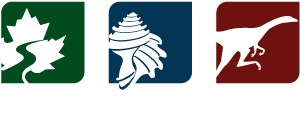Sauropterygia is an extinct clade of secondarily aquatic diapsid reptiles, which means that they evolved from reptilian ancestors that lived on land and not directly from fishes that spent their entire evolutionary history in aquatic environments. Examples include placodonts, nothosaurs, pachypleurosaurs, and plesiosaurs.
Researchers are not certain about the phylogenetic position of Sauropterygia within the reptilian lineage. Sauropterygians are well adapted for living in water, and these specializations obscure plesiomorphic traits (or, ancestral features; learn more) that typically help determine where a clade fits within a larger lineage. Various studies have hypothesized that Sauropterygia is most closely related to archosaurs, lepidosaurs, ichthyosaurs, or turtles. The question of sauropterygian relationships to other reptiles remains unresolved as researchers continue to investigate the subject (Chen et al., 2014; Scheyer et al., 2017).
General Morphology
The various clades that comprise Sauropterygia exhibit a range of morphologies based on differences in ecology, but there are some skeletal features that all the related taxa share.
Skull
Sauropterygians have a modified diapsid skull configuration in which the lower temporal fenestra has been lost due to reduction in the lower temporal bar. PLEASE DESCRIBE WHAT A TEMPORAL BAR IS

Pectoral girdle
A unique feature of Sauropterygia is the configuration of the pectoral girdle. All the pectoral girdle elements (clavicles, interclavicle, scapulae, and coracoids) were located on the bottom, or ventral, part of the body. In most reptiles, the clavicles are external to the scapulae (closer to the outer surface of the body), but in sauropterygians this relationship is switched and the scapulae are external to the clavicles (Carroll and Gaskill, 1985).

Limbs
Sauropterygians did not show reduction in the limbs, and all four limbs were likely used in propulsion by the derived, fully aquatic plesiosaurs.
Sternum and ribs
Sauropterygian skeleton also exhibit paedomorphosis, or the retention of juvenile characteristics in fully-grown adults. In this lineage, paedomorphosis is seen in a reduction of ossification, particularly in the post-cranial skeleton. This reduction in ossification resulted in some skeletal elements, such as the sternum, remaining cartilaginous throughout an individual’s life and in less well-developed joints than in their terrestrial ancestors (Rieppel, 2000a). Sauropterygians also had gastralia, or a series of belly ribs, that formed a bony basket between their pectoral and pelvic girdles.
Fossil Record
Sauropterygians originated during the Early Triassic, during the recovery from the end-Permian mass extinction. The clade diversified and thrived until the end-Cretaceous mass extinction, a span of approximately 185 million years. The region where sauropterygians originated is still unclear. New discoveries in Europe and China keep replacing each other as the oldest sauropterygian fossil, so the group originated somewhere in the shallows of the Tethys Sea. The more basal groups spread around the Tethys and beyond, likely remaining in coastal environment due to a lack of adaptations that would have made them strong swimmers able to transverse the open ocean. Sauropterygia did not achieve truly global distribution until the evolution of the more derived plesiosaurs at the end of the Triassic. Most sauropterygians remained in marine habitats, but some species have been found in sediments from estuaries and river systems.
Major Clades
Hallie - can you write a paragraph that introduces the several major clades of Sauropterygians? It would be useful to have that text, then show the phylogeny.


